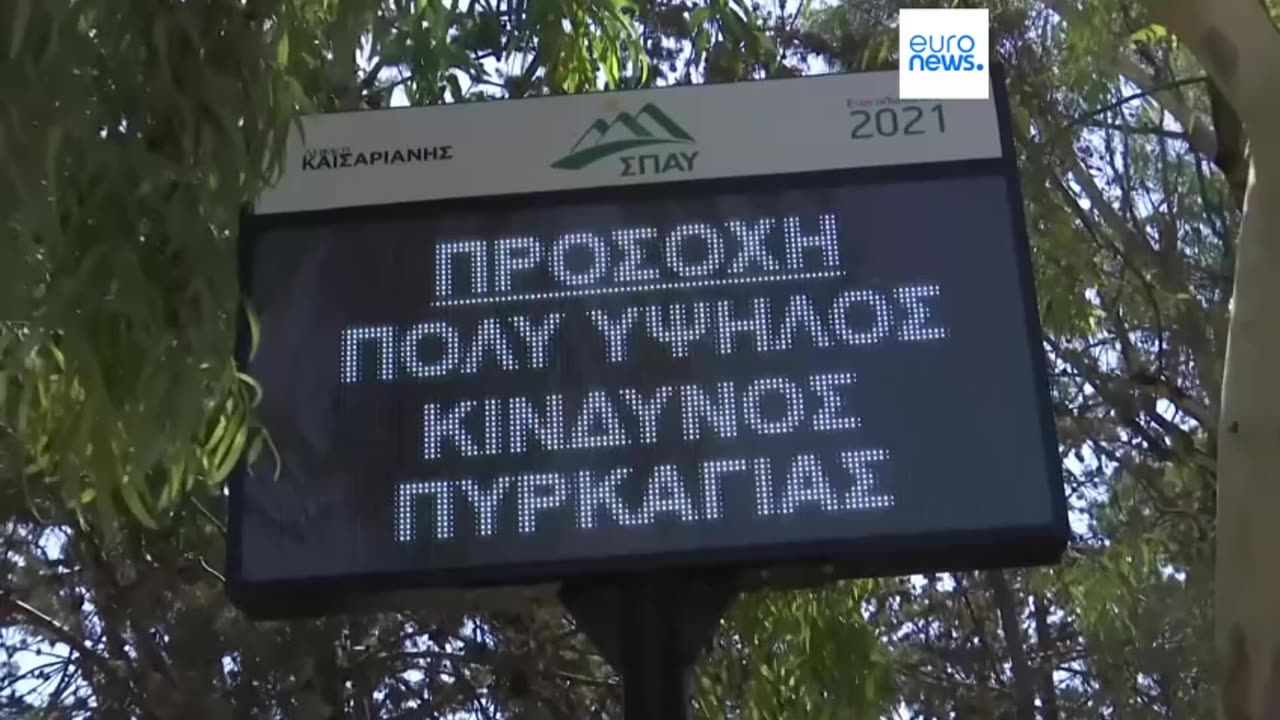Premium Only Content

Glutofenhitze in Griechenland
## Breaking News 2025: Navigating the Future of Information in a Hyper-Connected World
In an age defined by instant gratification and relentless digital currents, "breaking news" in 2025 is more than just a headline; it's a dynamic, multi-faceted ecosystem. As technology continues its exponential leap, particularly in the realm of Artificial Intelligence (AI), the landscape of how we consume, produce, and interact with real-time information is undergoing a profound transformation. This article delves into the evolving nature of breaking news in 2025, exploring the pivotal features, seamless integrations, diverse pricing models, and the inherent pros and cons of this hyper-accelerated news environment.
### The Pulse of 2025: Major Anticipated News Events
The year 2025 is already set to be a significant period on the global stage, with a confluence of events poised to generate major breaking news cycles. From geopolitical shifts to technological breakthroughs, and from major sporting spectacles to cultural milestones, the world will be watching.
On the geopolitical front, ongoing conflicts and evolving international alliances continue to dominate headlines. The aftermath of various 2024 elections, particularly in major global powers, will likely shape policy decisions and international relations throughout 2025, potentially leading to new economic agreements, diplomatic tensions, or even humanitarian crises. For instance, the potential return of certain political figures to power could significantly impact international cooperation and existing treaties, leading to substantial breaking news as policies shift. Regional instabilities, such as those in the Middle East, remain a critical concern, with any escalation having immediate global ramifications.
Technologically, 2025 is anticipated to be a year where AI moves beyond experimentation into widespread functional integration across various industries. Expect breaking news around new AI-driven innovations, regulatory discussions surrounding ethical AI use, and the economic impacts of increased automation. Breakthroughs in quantum computing, sustainable energy solutions, and advanced medical treatments could also generate significant global interest and widespread reporting.
Major sporting events, such as the FIFA Club World Cup in the United States and the World Athletics Championships in Tokyo, will undoubtedly capture international attention, providing a continuous stream of results, analyses, and human-interest stories. Cultural phenomena, including the Eurovision Song Contest in Switzerland and significant artistic exhibitions, will also contribute to the vibrant tapestry of breaking news. Even celestial events like the Total Lunar Eclipse in September will offer stunning visuals and scientific discussions, becoming breaking news for astronomy enthusiasts and beyond.
Furthermore, social and economic shifts will continue to unfold. Discussions around climate change, global economic inequality, and digital governance will intensify, leading to summits, protests, and policy announcements that become immediate news. The evolving nature of work, driven by AI integration and changing labor market demands, will also be a constant source of news, impacting millions globally.
### Features of Breaking News Platforms in 2025
The breaking news platforms of 2025 are designed for speed, accuracy, and hyper-personalization, leveraging cutting-edge technology to deliver information in unprecedented ways.
* **AI-Powered Content Curation and Summarization:** Gone are the days of endless scrolling. AI algorithms are central to filtering the deluge of information, identifying truly breaking stories, and presenting them to users based on their interests and past consumption habits. Many platforms offer AI-generated summaries at the top of articles, providing quick overviews for busy readers. This also extends to summarizing related news articles from various sources into neutral language, as seen in platforms like Ground News and Rize.
* **Real-time Updates and Live Feeds:** Immediate updates are paramount. Platforms feature dedicated live blogs and real-time news feeds that refresh instantaneously as events unfold. This includes live video streaming, audio commentary, and direct integration with on-the-ground reporting. News data APIs like NewsData.io and NewsAPI are crucial here, providing real-time access to news feeds from thousands of sources globally.
* **Multi-format Delivery:** News is no longer just text. Expect a seamless blend of text, high-definition video, interactive infographics, 3D visualizations, and even immersive augmented reality (AR) experiences. Video content, particularly short-form social video, is becoming increasingly dominant, with platforms prioritizing this format. Podcasters and "news creators" on platforms like YouTube and TikTok are also significant emerging news sources.
* **Hyper-Personalization:** Users have granular control over their news consumption. Feeds are highly customizable, allowing users to select specific topics, regions, sources, and even political leanings (as offered by Ground News, which shows political bias distribution). AI-driven recommendations learn and adapt to individual preferences over time, ensuring a highly relevant news experience.
* **Interactive and Community Features:** Engagement is key. Platforms incorporate robust comment sections, live Q&A sessions with journalists, polling features, and integration with social media to foster discussion and community around breaking stories. Some even allow users to curate their own "magazines" of content, like Flipboard.
* **Advanced Search and Filtering:** Locating specific information quickly is crucial. Enhanced search capabilities allow users to filter by keywords, dates, sources, locations, and even sentiment, making it easier to drill down into complex events.
* **Offline Reading and Notifications:** For on-the-go consumption, many platforms offer offline reading modes. Highly customizable push notifications ensure users are alerted to critical breaking news directly on their devices, with options to tailor notification frequency and topic relevance.
* **Fact-Checking and Source Verification Tools:** In an era of misinformation, platforms are integrating more robust fact-checking mechanisms, often powered by AI, and clearly displaying source credibility ratings to help users discern reliable information.
* **Accessibility Features:** Voice-to-text, text-to-speech, and multi-language translation capabilities are becoming standard, making breaking news accessible to a wider audience. AI is widely expected to make news translation more efficient and accurate.
### Integrations: The Interconnected News Landscape
The breaking news ecosystem in 2025 is deeply integrated, allowing for seamless information flow and enhanced user experiences across various platforms and applications.
* **Social Media Integration:** While some traditional news outlets might be wary of over-reliance on social media, the reality is that platforms like TikTok, YouTube, Instagram, and X remain significant conduits for news consumption, especially among younger demographics. Breaking news platforms integrate closely, allowing for easy sharing, embedding of social content, and monitoring of trending discussions.
* **AI and Data Platforms:** The backbone of modern breaking news lies in its integration with advanced AI and data analytics platforms. These integrations enable real-time data processing, sentiment analysis, predictive modeling for emerging stories, and automated content generation (for summaries or even basic news reports). News data APIs provide crucial access for AI applications, finance, and risk management to integrate real-time, historical, and structured news data.
* **Smart Devices and Wearables:** Breaking news is increasingly delivered directly to smart home devices, smartwatches, and in-car infotainment systems. Voice assistants can provide audio briefings, and push notifications keep users updated without needing to open a dedicated app.
* **API-Driven Feeds:** News organizations are increasingly using APIs (Application Programming Interfaces) to syndicate their content to various aggregators, third-party applications, and internal systems. This ensures their content reaches a wider audience and can be repurposed for different contexts, such as financial trading platforms or risk management dashboards.
* **Collaboration Tools:** For newsrooms, seamless integration with project management tools, communication platforms, and content management systems is essential for rapid news production and dissemination.
* **Advertising and Monetization Platforms:** Integrations with ad networks, subscription management systems, and e-commerce platforms are crucial for the financial sustainability of news organizations, allowing for targeted advertising and seamless subscription experiences.
* **Archival and Research Databases:** Integration with vast news archives and research databases allows for journalists to quickly contextualize breaking stories with historical information and verified data, adding depth and credibility to reports.
### Pricing Models: Accessing Premium Breaking News
The pricing strategies for breaking news in 2025 are diverse, reflecting the varying needs and willingness to pay of consumers and enterprises.
* **Freemium Models:** Many news platforms operate on a freemium model, offering a substantial amount of content for free, but reserving premium features, in-depth analysis, ad-free experiences, and exclusive content for paying subscribers. This allows for broad reach while incentivizing subscriptions for dedicated users.
* **Subscription Tiers:** Tiered subscription models are common, offering different levels of access and features at varying price points. A basic tier might provide ad-supported access to most content, while higher tiers offer ad-free experiences, offline downloads, exclusive newsletters, early access to investigative reports, or even personalized consultations with expert journalists.
* **Bundled Subscriptions:** News organizations are increasingly bundling their offerings with other digital services, such as streaming platforms, e-books, or even broadband internet, to increase value and attract new subscribers. This is particularly effective in markets with high trust in national media and a culture of bundled offers.
* **Pay-per-Article/Micro-payments:** While less common for general breaking news, some niche or highly specialized news outlets might offer micro-payment options for individual articles or reports, catering to users who only need occasional access to specific content.
* **Enterprise Solutions:** For businesses, financial institutions, and academic institutions, specialized breaking news services offer premium data feeds, advanced analytics, and custom integrations, often priced based on usage volume, number of users, or specific data requirements. News data APIs, for example, often have pricing models based on calls or subscriptions.
* **Advertising-Supported (with AI-driven targeting):** Free news platforms continue to rely on advertising, but in 2025, AI-driven ad targeting is significantly more sophisticated, delivering highly relevant ads to users based on their real-time consumption and demographic data. However, there's a shift away from "riskier" contexts like hard news for some advertisers.
* **Donation/Membership Models:** Some independent or non-profit news organizations rely on reader donations or membership programs, offering varying perks to contributors, fostering a sense of community and direct support for quality journalism.
### Free Trial and Demo: Experiencing the Future of News
To entice new users and demonstrate the value of their advanced features, breaking news platforms in 2025 widely offer free trials and interactive demos.
* **Generous Free Trials:** Most premium news services provide free trial periods, typically ranging from 7 days to several months. These trials offer full access to all features, allowing users to experience the platform's personalization, real-time updates, and multi-format content without commitment. Apple News+, for example, offers a 3-month free trial with the purchase of an eligible Apple device.
* **Interactive Demos:** For enterprise solutions or highly specialized news feeds, interactive demos are crucial. These often involve a guided tour of the platform's capabilities, showcasing its data integration, analytical tools, and customization options tailored to specific industry needs.
* **Freemium Features as "Demos":** The free tier of a freemium model can effectively serve as an ongoing demo, allowing users to experience the basic functionality and quality of content before deciding to upgrade to a paid subscription.
* **API Sandboxes and Developer Accounts:** For developers interested in integrating news data into their own applications, many news API providers offer free tiers or sandbox environments. NewsData.io and GNews API offer free plans with a certain number of daily or monthly requests for development and testing purposes. This allows developers to experiment with the data and assess its suitability for their projects.
* **Personalized Onboarding:** During free trials, users often receive personalized onboarding experiences, including tutorials, tips, and dedicated support to help them maximize their trial period and understand the platform's full potential.
### Pros of Breaking News in 2025
The advancements in breaking news in 2025 bring numerous advantages for consumers and the dissemination of information.
* **Instantaneous Information:** The most obvious benefit is the speed at which information travels. Users can be informed of significant events almost as they happen, regardless of their location, fostering a more globally aware populace.
* **Hyper-Personalization and Relevance:** Users receive news that genuinely interests them, filtering out noise and focusing on topics, regions, and sources that matter most. This leads to a more engaging and efficient news consumption experience.
* **Diverse Perspectives:** With advanced filtering and aggregation tools, users can easily access multiple perspectives on a single story, including varying political biases and international viewpoints, promoting a more nuanced understanding of complex events. Platforms like Ground News specifically cater to this need.
* **Accessibility:** Multi-format delivery, AI-powered translation, and accessibility features ensure that breaking news is available to a wider audience, including those with disabilities or language barriers.
* **Enhanced Context:** AI's ability to summarize, link to related articles, and integrate with historical data allows for a richer understanding of breaking stories, providing immediate context that was previously difficult to obtain quickly.
* **Direct Access to On-the-Ground Reporting:** Technology facilitates direct reporting from the scene of events, often through citizen journalism or live streams from affected areas, providing raw, unfiltered glimpses of breaking situations.
* **Community Engagement:** Interactive features foster discussion and allow users to engage directly with the news and with each other, creating a more dynamic and participatory news environment.
* **Efficiency for Professionals:** For industries like finance, marketing, and risk management, real-time news APIs and analytics provide critical, actionable insights, enabling faster decision-making and better risk assessment.
### Cons of Breaking News in 2025
Despite its advantages, the rapid evolution of breaking news in 2025 presents several significant challenges and drawbacks.
* **Increased Risk of Misinformation and Disinformation:** The speed of information dissemination, coupled with the rise of AI-generated content (including deepfakes and manipulated media), makes it increasingly difficult to discern truth from falsehood. Online influencers and personalities, while sometimes offering valuable insights, are also identified as major sources of misleading information. Trust in news, while stable, is a constant concern.
* **Information Overload and News Fatigue:** The sheer volume of constantly updating information can be overwhelming, leading to anxiety, disengagement, and "news fatigue" as individuals struggle to process the relentless stream of headlines.
* **Echo Chambers and Filter Bubbles:** While personalization offers relevance, it can also inadvertently create "echo chambers," where users are primarily exposed to information that confirms their existing biases, limiting their exposure to diverse viewpoints.
* **Reduced Depth and Context:** The emphasis on speed can sometimes come at the expense of in-depth analysis and comprehensive reporting. Short summaries and rapid updates might lack the nuanced context necessary for a full understanding of complex issues.
* **Erosion of Trust in Traditional Media:** The rise of alternative news sources, coupled with concerns about bias and misinformation, can erode public trust in established news organizations, making it harder for credible journalism to stand out.
* **Privacy Concerns with Personalization:** The extensive data collection required for hyper-personalization raises privacy concerns, as user behavior and preferences are meticulously tracked and analyzed.
* **Technological Divide:** Access to the most advanced breaking news features and platforms may be limited to those with high-speed internet, powerful devices, and the financial means to subscribe to premium services, exacerbating existing digital divides.
* **Dependence on Algorithms:** The reliance on AI algorithms for content curation means that editorial judgment can be subtly influenced by computational models, potentially leading to a de-emphasis on certain stories or perspectives that don't fit algorithmic parameters.
* **Monetization Challenges for Publishers:** While subscription models are evolving, many news organizations still struggle to find sustainable monetization strategies in a highly competitive and fragmented digital landscape, especially as advertisers shift away from news content.
* **Ethical Implications of AI in Journalism:** The increasing use of AI in content creation and summarization raises ethical questions regarding journalistic integrity, accountability for AI-generated errors, and the potential displacement of human journalists.
### Conclusion: A Dynamic Future for Breaking News
Breaking news in 2025 is a testament to humanity's unyielding demand for information and the relentless pace of technological innovation. While the pursuit of immediate, personalized, and multi-faceted news delivery offers unprecedented opportunities for global awareness and engagement, it also necessitates a critical and discerning approach from consumers. The challenges of misinformation, information overload, and algorithmic biases are real, demanding continuous efforts from both news producers and consumers to ensure the integrity and value of real-time information.
As the year unfolds, the breaking news landscape will continue to adapt, shaped by advancements in AI, evolving consumer habits, and the ever-present human need to understand the world around us. Navigating this dynamic environment will require a blend of technological literacy, critical thinking, and a commitment to seeking out diverse and credible sources. The future of breaking news is not just about the speed of delivery, but about the intelligent consumption and responsible dissemination of information that empowers individuals and strengthens societies.
-
 LIVE
LIVE
The Mike Schwartz Show
3 hours agoTHE MIKE SCHWARTZ SHOW with DR. MICHAEL J SCHWARTZ 09-17-2025
4,181 watching -
 LIVE
LIVE
Mally_Mouse
20 hours ago📣Telescreen Talks - LIVE!
188 watching -
 LIVE
LIVE
Quite Frankly
6 hours agoPsychotic Voices from Another World, Part 2 | Jerry Marzinsky & Judy Gregerson 9/17/25
640 watching -
 LIVE
LIVE
SpartakusLIVE
2 hours agoTower DOMINATION, Specialist, and INFINITE Dubs || Duos w/ Twitty , Quads Later w/ The Boys
213 watching -
 7:04:40
7:04:40
Dr Disrespect
8 hours ago🔴LIVE - DR DISRESPECT - ARENA BREAKOUT: INFINITE - ESCAPE OR LOSE EVERYTHING!
126K4 -
 LIVE
LIVE
SavageJayGatsby
1 hour ago📣Telescreen Talks - LIVE!
90 watching -
 1:07:53
1:07:53
TheCrucible
3 hours agoThe Extravaganza! EP: 38 (9/17/25)
114K16 -
 1:12:15
1:12:15
Candace Show Podcast
3 hours agoWho Ordered The Hit On Charlie Kirk? | Candace Ep 237
77K267 -
 31:19
31:19
Rethinking the Dollar
9 hours agoMartin Armstrong Predicts 2032 Collapse — Are You Ready? (w/ Kerry Lutz)
18.3K5 -
 DVR
DVR
Redacted News
4 hours agoThey're LYING about Charlie Kirk's murder and they know it, new details just emerged | Redacted
210K158